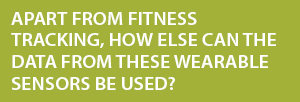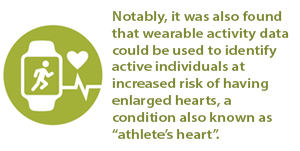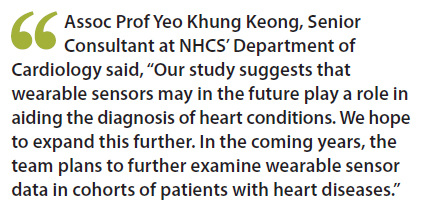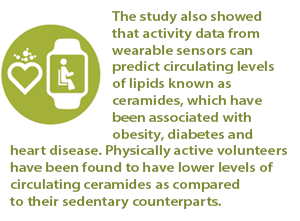Wearable sensors help predict heart problems
Research team from the SingHealth Duke-NUS Institute of Precision Medicine (PRISM) and National Heart Centre Singapore (NHCS) found that wearable sensors are not just useful for personal fitness tracking, but can also enhance biomedical research and may help predict cardiovascular and metabolic diseases.
With a more health-conscious population, coupled with advancements in medical and digital technologies – it is no wonder that wearable sensors such as fitness trackers and smartwatches are becoming common. Some even consider them as trending 'fashionables'. Most often used for tracking physical activities, some wearable sensors can even track calories burnt, sleeping patterns and heart rate, thus keeping tabs on one's general health and wellness.

233 volunteers were subjected to a series of clinical tests, and activity trackers were used to monitor their activities and heart rates. Results showed that apart from wearable sensors being able to identify groups of volunteers with distinct behavioural characteristics, data collected on heart rate (at rest) were notably found to be associated with risks of cardiovascular and metabolic diseases.

Resting heart rate was evaluated against risk markers such as high body mass index (BMI), high waist circumference, and high total cholesterol, among others, and proved to be a better performer at predicting one's risk of developing a cardiovascular and metabolic disease as compared to activity data. Notably, it was also found that wearable activity data could be used to identify active individuals at increased risk of having enlarged hearts, a condition also known as "athlete's heart".
This was commonly thought to only affect competitive athletes whereby the heart enlarges to cope with the increased demand for oxygen intake during exercise. The activity data from wearables may help us to identify individuals who are more likely to have this condition due to exercise, as such patients have a higher chance of being misdiagnosed as having underlying heart disease in the clinic.
The study also showed that activity data from wearable sensors can predict circulating levels of lipids known as ceramides, which have been associated with obesity, diabetes and heart disease. Physically active volunteers have been found to have lower levels of circulating ceramides as compared to their sedentary counterparts. Drawing such a correlation is only possible if the researchers studying the interaction between lifestyle and lipid metabolism have relied on comprehensive questionnaires or expensive experimental studies.


The study has shown how activity data could help define risk markers for cardiovascular and metabolic diseases. Since activity data is readily available with wearable technologies, future studies could even be conducted using wearable sensor data donated by the public. Assoc Prof Yeo Khung Keong, Senior Consultant at NHCS' Department of Cardiology said, "Our study suggests that wearable sensors may in the future play a role in aiding the diagnosis of heart conditions. We hope to expand this further. In the coming years, the team plans to further examine wearable sensor data in cohorts of patients with heart diseases."
The study's findings have been published in the journal PLOS Biology. Funding for the study was provided by SingHealth, Duke-NUS Medical School, NHCS, Singapore National Medical Research Council, the Lee Foundation and the Tanoto Foundation.
This article was first published in NHCS' newsletter Murmurs Issue 30.
